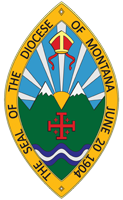Diocese of Montana Newsletter, May 2020

At the Eucharist, we break bread to share with one another and offer blessed and consecrated wine in a common chalice.
The use of a common cup, a cup or chalice shared by all those gathered, comes from our biblical texts of Jesus’ institution of the Eucharist. Traditionally, that meal was in the context of a Passover meal within which is something call a ‘cup of blessing’. While there are no written Haggadah texts from the first century (the written texts that guide a Passover meal), traditionally this cup of blessing was thought to be shared commonly, passing it from one end of the gathering to another. The theology behind this is that the bread and wine is offered to God and we are blessed to share in that meal as members of Christ’s family. For the writings of Herbert Anderson and Edward Foley in Mighty Stories, Dangerous Rituals, “In the memory of the early disciples, Jesus’ table ministry was the ultimate enacted parable. It was the paradigm of storytelling and ritual making where the human and divine ultimately converged. Share a piece of bread, drinking from a common cup-both expressed and created the union they symbolized.”
The people of the Christian faith have wrestled with this intimate theology over the centuries as well as the social implications of sharing a meal with “others”. Paul had to bring the Corinthians up short when they refused to share freely with the whole gathering at their agape meals. The common cup was anchored in the Christian faith from the first century onward. But for many centuries, the Western Church only offered the bread to the faithful laity. The cup became reserved for the clergy only. In the sixteenth century, the sharing of the common cup was a central part of the English Eucharistic reformation and has been central to all parts of the Anglican Communion to this day. Only in times of public health crises has this been suspended, and even then it has been hotly debated. Scientists in the 20th and 21st centuries have studied whether the chalice could be a spreader of disease: to date the answer is no. It seems to me that the argument is not what the argument is about. So why have we wrestled with the common cup and not the bread? Let me share this story that Bishop Michael Curry tells. (click below to continue reading)
Click here to read the complete newsletter, including the following:
- The Common Cup: Problems and Promises
- COVID-19 Recovery - Phase I
- Around the Diocese
- Camp Marshall Going Virtual
- Explore the Way of Love with new video series
- St. Patrick's, Bigfork - Renovation
- Finance Corner, by Barb Hagen: Reflections
- Presiding Bishop Michael Curry's Word to the Church: What Would Love Do?
- All Saints' Columbia Falls/Whitefish - Renovation
- 2020 Diocesan Convention
- Clergy Conference rescheduled, Sept. 1 - 3
- Cybercrime in Montana
- Episcopal Service Corps reflections on serving during COVID-19
- Sunday Message - Third Sunday of Easter
- Community Garden at St. Patrick's, Bigfork
- Technology Tutorials
- Camp Marshall: video
- Safeguarding God's People class
- National Episcopal Youth Event postponed
- Ecumenical opportunities
- Association of Episcopal Deacons' A3D Conference gratitude
- St. James, Bozeman, hiring part-time Youth Director
- Ecumenism on the National Level: The National Council of Churches
- Episcopal Relief & Development
